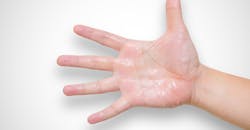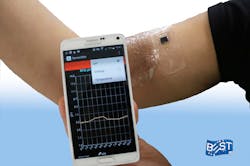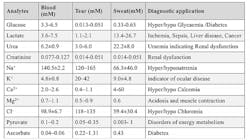New Wearable Sensor May Soon Replace Blood Tests
The potential data that can be captured from sweat is equal to that of a blood test. The traditional check for chronic diseases is analyzing a blood sample. However, it is possible to use sweat and tears for the same tests as they contain similar analytes (biomarkers). A research team from the University Glasgow has developed a stretchable sensor that can measure sweat, using it to perform the same tests that would require blood.
The Sensor that Stretches
The non-invasive sensor can measure the patient’s pH levels via their sweat. The data is then transmitted to the patient’s smartphone for real-time monitoring on the SenseAble app. (Image credit: University of Glasgow)
The UK-based Bendable Electronics and Sensing Technologies (BEST) group works out of the University of Glasgow. It has developed a new sweat-based, non-invasive sensor directed at monitoring diabetes. The article, entitled “Stretchable wireless system for sweat pH monitoring,” was recently published in the journal Biosensors and Bioelectronics. This work was conducted by Wenting Dang, Libu Manjakkal, William Taube Navaraj, and Ravinder Dahiya from the University of Glasgow; Leandro Lorenzelli from the Fondazione Bruno Kessler; and Vincenzo Vinciguerra from STMicroelectronics. The sensor was developed via the EU-funded project CONTEST.
The wearable uses a pH sensor made from graphite-polyurethane composite, stretchable radio-frequency-identification (RFID) antenna, and a flexible data transmission printed circuit board (PCB). The sensor area is 1 cm2 and can stretch up to 53% in length due to a pair of serpentine-shaped interconnecting pieces.
While stretched, the sensor can maintain its strong performance levels, and further product testing has shown that the sensor can withstand being stretched by 30% up to 500 times. This ensures durability and longevity of the sensor. The device can provide results within 8 sec. and responds to pH levels between 5 and 9. The reliability of the sensor is up to 20% strain.
How Sweat Compares to Blood
Sweat contains several different chemical indicators. These include sodium, potassium, and glucose, and they have nearly zero impact on the pH sensor’s performance. “Human sweat contains much of the same physiological information that blood does, and its use in diagnostic systems has the significant advantage of not needing to break the skin in order to administer tests,” says Professor Ravinder Dahiya. The chart below lists the different substances that can be measured via sweat as compared to blood.
The chart lists various analytes and the range of each that can be found in a blood, tear, or sweat sample. (Image credit: Corrie et al., 2015; Farandos et al., 2015; Tinku et al., 2014).
Once the system measures the sweat, it will send the data wirelessly to the receiving computer via near-field communications (NFC). Other wireless systems transmit data via Bluetooth technology which causes the sensors to exert more energy resulting in greater power drains. By using the NFC technology, the pH data is sent via a RFID antenna to the patient’s smartphone. The research team developed the SenseAble smartphone app to allow users to track their pH levels in real-time.
The sensor can only measure pH at the present moment, but the team is looking to expand the technology. “Now that we’ve demonstrated that our stretchable system can be used to monitor pH levels, we’ve already begun additional research to expand the capabilities of the sensor and make it a more complete diagnostic system,” says Dahiya. The future of the sensor will allow patients to monitor their glucose, ammonia, and urea.



